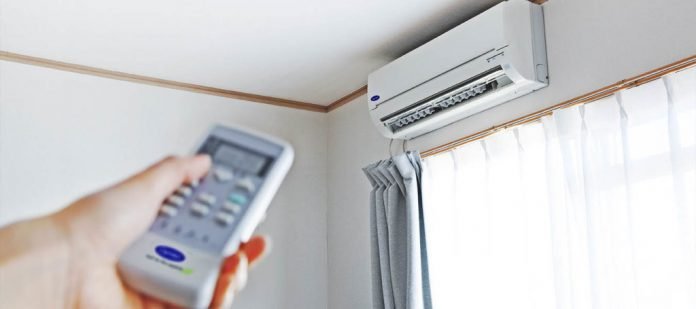Last Updated on August 15, 2023 by
Indian summers are getting hotter and hotter by the year. The summer of 2019 was India’s 7th warmest year since recording began in 1991. Sweltering heat during the summer months can lead to a host of physical ailments and discomforts as dangerous as premature heart strokes, dizziness, muscle spasms, and major nausea. Investing in air conditioning can help you beat the heat of the summer. Considering buying a split AC for this summer? Here is your guide to buying a split air conditioner.
Table of Contents
What is a Split AC?
Split ACs are called so because they have two separate (or split) units, unlike traditional window ACs that come with a single unit. The unit outdoors for the best split air conditioner is typically installed close to or on top of an exterior wall of the room that one wishes to cool. It houses the condenser coil, compressor, and the capillary tubing or expansion coil. The sleek indoor unit that provides air conditioning consists of a long blower, an internal cooling coil, and an air filter.
Advantages of Split AC vs Window AC
- Split air conditioners are known to make lesser noise, as their compressor and fan of the condenser (the primary source of noise) are located in the outdoor unit out of the room being cooled. A window AC’s unit is located partially indoors, through a hole in the wall, and hence their sound is quite noticeable.
- Another key difference is the uniformity in cooling when it comes to a Split AC vs Window AC. The former offer more uniform cooling due to their location and shape.
- Split air conditioners are known to be long-term cost-effective options. While their initial costs of installation are higher than window ACs, they yield returns through their energy-conserving use of power. Window ACs tend to consume more power over time.
- Another difference between window AC vs split AC is that the former allows for a multi-split system. Hence, you can choose to power one or more indoor units using the same outdoor unit. This is not possible with Window ACs.
Features to Consider When Buying a Split AC
When it comes to buying an AC, there are certain characteristics that may make one brand preferable over another. There are certain things buyers should look out for in their split air conditioner before making a purchase. While there exist less critical factors such as air quality, cooling speed, and maintenance, we will focus on the most essential ones.
Inverter AC vs Non-Inverter AC
Both window and split ACs can be either non-inverter ACs or inverter ACs. An inverter AC is known to adjust the rate of its compressor, and thereby control the rate of the cool air flowing out. Inverter ACs maintain the room temperature better and consume less electrical power as they can adjust compressor-speed. Alternatively, non-inverter ACs come with a fixed rate to cool. Non-inverter ACs start or stop their compressors and cannot adjust them to check the room temperature.
Tonnage Level
AC brands like Hitachi, Bluestar, LG, Godrej Voltas display the tonnage of their split air conditioner models online for customers to consider. But what does it mean? Tonnage is a way of assessing the amount of heat an AC can eliminate from the area it is cooling in 60 minutes. In other words, tonnage is the cooling capacity of an air conditioner.
To determine the amount of tonnage the AC you want to buy should have, this should be your rule of thumb: The bigger the room, the greater the tonnage. But what about the specifics? Here’s what experts say:
- 1-ton split AC: sufficiently cools rooms that are smaller than 140 sq.ft.
- 1.5-ton split AC: sufficiently cools rooms sized between 140 to 180 sq.ft.
- 2-ton split AC: sufficiently cools rooms larger than 180 sq.ft.
BEE-Star Grading
One can always find a strong split air conditioner that also conserves energy. For those looking to lower their carbon footprint, and reduce their electricity bill, energy efficiency is the feature to consider in a Split AC. Energy Efficiency measures how much electrical power your Split AC consumes for the maximum cooling it provides. ‘BEE stars’- are a five-point grading system that rates how energy efficient, and hence, environmentally friendly and cost-effective your AC is. BEE stars come printed as a 1-5-star rating on the indoor unit, or on your Split AC’s box.
Finding an AC that has 5 BEE stars is the gold standard for an energy-efficient air conditioner. These units consume the least amount of electrical power and offer great cooling capacity for it. Unfortunately, 5 BEE stars are rare across most appliances, although there are some split ACs that boast this rating. If environmental impact, and value for the cost is your goal, seek out at least 3 BEE stars in the split AC of your choosing, as this is more readily available in India.
Where to Buy Your Split AC
Now that you have all the necessary information to purchase a split air conditioner, where should you buy it from? Bajaj Finserv EMI Network currently offers the best split ACs in the market easy EMIs in more than 1,900 Indian cities. With all essential brands such as Hitachi, Haier, Blue Star, LG, Godrej, and Voltas, the Bajaj Finserv EMI Network is a one-stop shop for you to purchase your split AC.Advantages of buying with Bajaj Finserv EMI Network include providing minimal documentation, instant loan approval, and hassle-free transactions under 3 minutes. We offer an online store locator which holds more than 1 lakh stores to conveniently help you locate a store closest to you. To browse the best split ACs models on Bajaj Finserv EMI Network.
Apart from this if you are interested to know about Top 4 Home Improvement Projects To Tackle Before Moving then visit our home improvement category



























